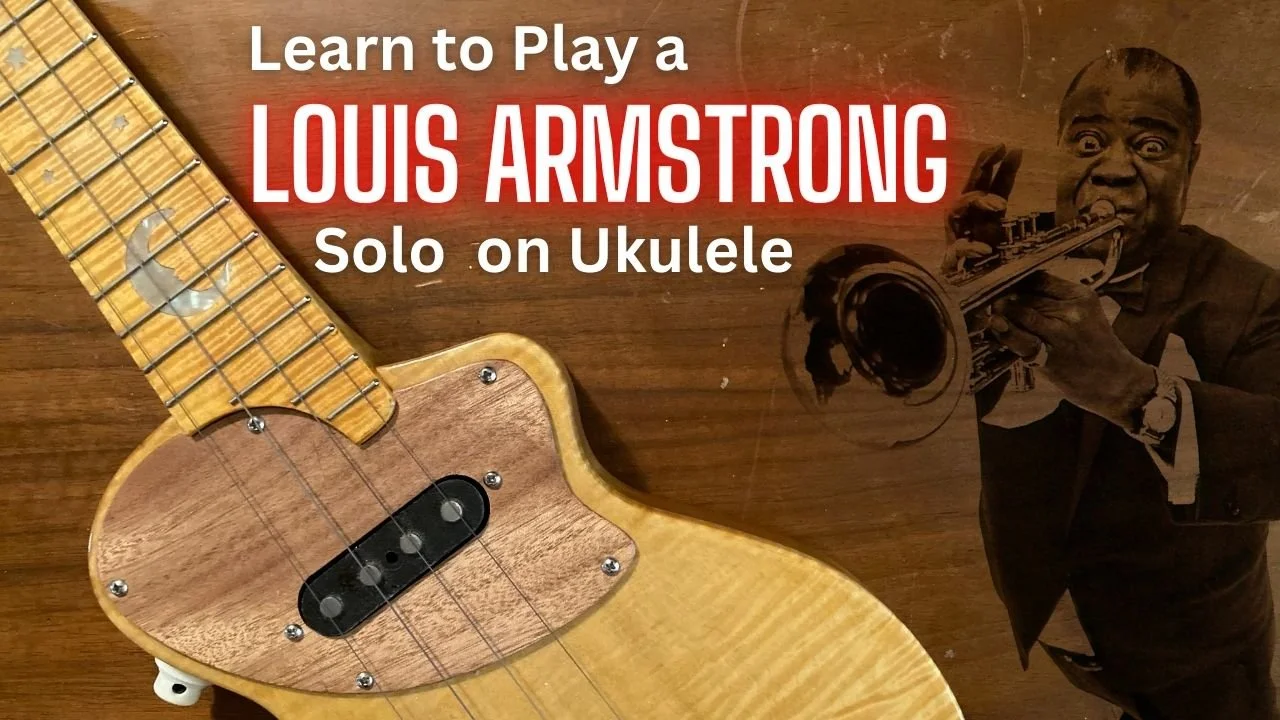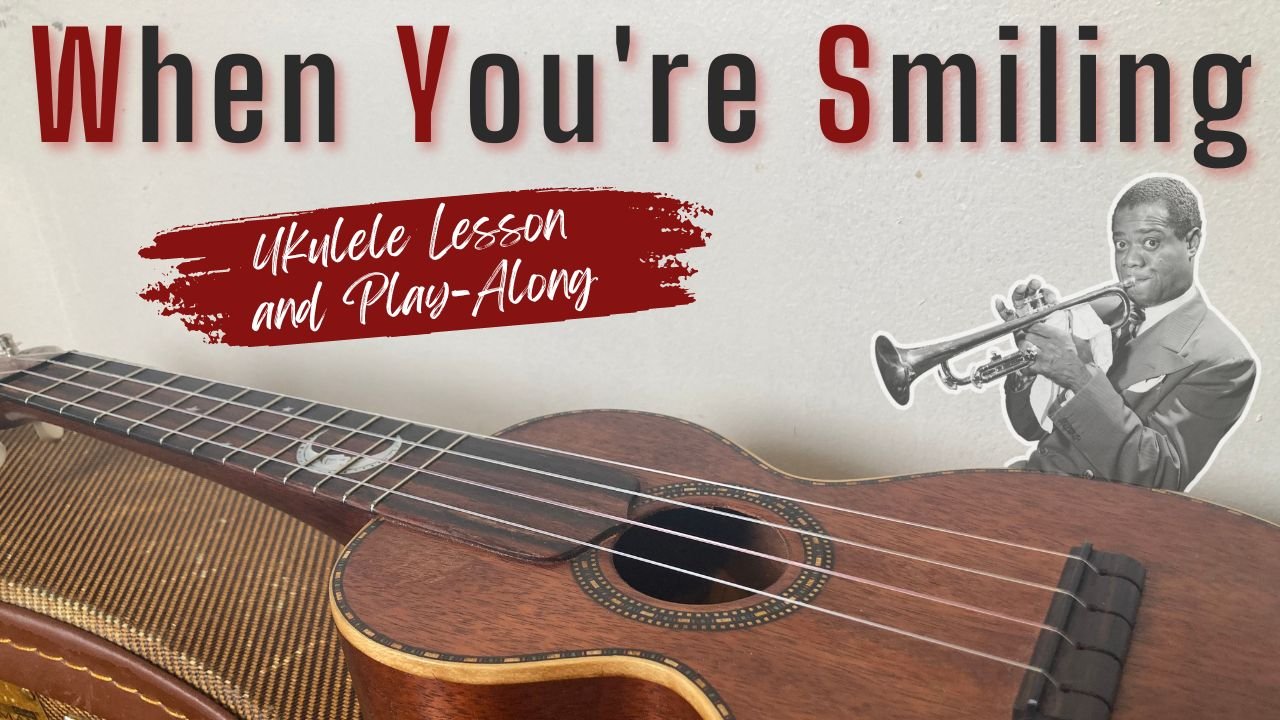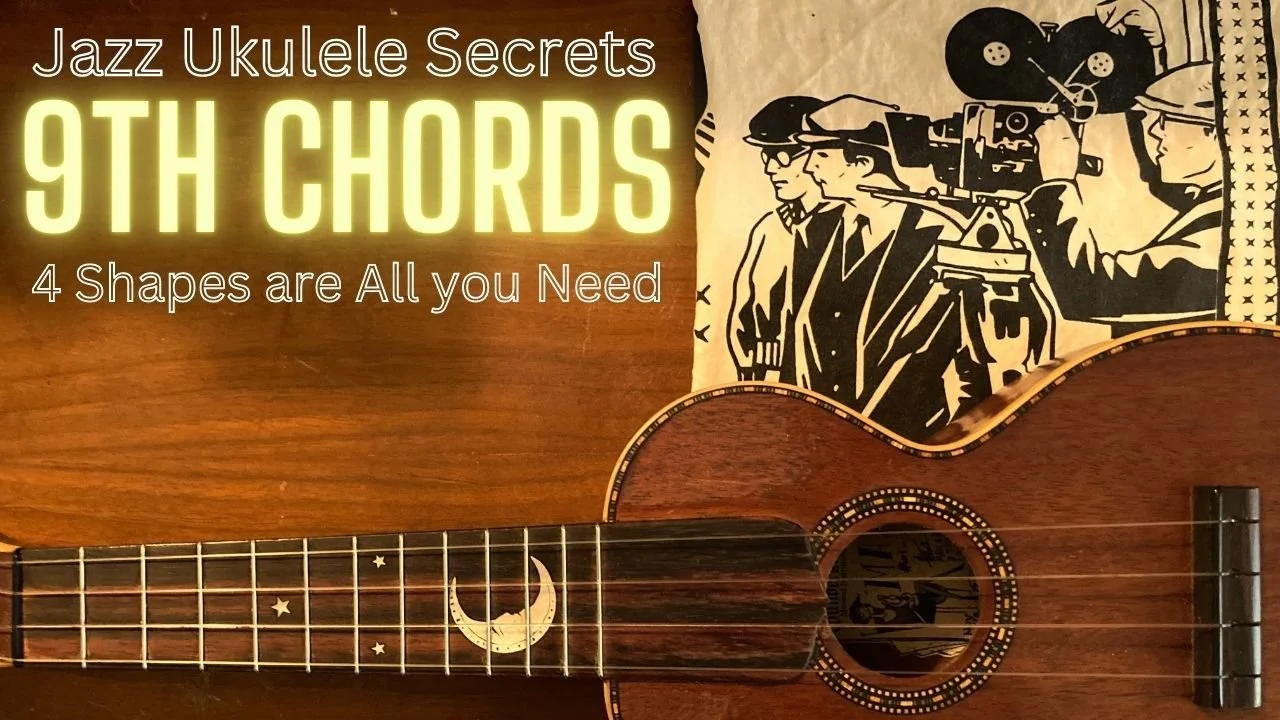It's not often that you find a jazz solo that fits the limited range of ukulele but When You're Smiling Gives us a unique opportunity to learn one from the master himself: Louis Armstrong. In this lesson we cover how to play this iconic solo from his 1929 recording. The best part is that three chords shapes are all you need to play most of it!
Free PDF tabs/notation: https://www.thetinman.co/smilingsolo
This month on the Magic Ukulele Club we'll be learning this Louis Armstrong Classic 1929 solo, chord substitutions and more using this fabulous standard as a vehicle. Join us today to learn a new jazz standard each month, along with 200+ other jazz ukulele lessons, livestreams, backing tracks, and more for only $7.50 a month
Read MoreWritten in 1928 'When You're Smiling was an instant hit for Louis Armstrong and subsequently became a jazz standard recorded hundreds of times by artists from Ella Fitzgerald to Louis Prima To Fats Domino over the years. In this ukulele lesson we look at the basic chord structure which uses two common chord progressions: I VI ii V and the Honeysuckle Rose Bridge and then try the tune along with the backing track.
This month on the Magic Ukulele Club we'll be learning Louis Armstrong's Classic 1929 solo, chord substitutions and more using this fabulous standard as a vehicle. Join us today to learn a new jazz standard each month, along with 200+ other jazz ukulele lessons, livestreams, backing tracks, and more for only $7.50 a month
Read MoreOnce you have mastered your 7th chords it’s time to start adding on the next extension to give them a different flavor: the 9th. These four chord voicings can be used to play your 9th chords in any key as well as serving triple duty as m7b5 and m6 chord voicings. Understanding these shapes can be a key to unlocking the fingerboard and taking your chords to the next level.
This month on the Magic Ukulele Club we’re putting these chords to use over the classic tune ‘Please Don’t Talk About Me When I’m Gone’ not just using them as chords but as the foundation for building a chord melody solo
Read MoreThis month on the Magic Ukulele Club we’re learning the 1930 standard ‘Please Don’t Talk About Me When I’m Gone’. What could a simple 5 chord song teach us? An awful lot! This song contains two of the most used chord progressions in this style and works as a great platform for chord substitution. This month we’ll be learning all about adding 9th chords in place of 7ths as well as building a chord melody solo from scratch.
Read MoreWhat if I told you to stop thinking about chord changes and scales in jazz just focus on one note in your soloing? Let's build a ukulele solo over top of Gershwin's 'Oh Lady Be Good' starting with just a single note and seeing where it can take us! This riff based style of playing was popular with early swing players such as the great Charlie Christian.
Join the Magic Ukulele Club for an hour of video lessons working the melody,.chords, comping, as well as a backing track to practice with, and three guided practice livestreams on this iconic 1924 Gershwin jazz standard. Each month on the Magic Ukulele Club we work through a new jazz standard on ukulele.
Read MoreThis month in the Magic Ukulele Club we’re working our way through the 1924 Gershwin standard ‘Oh, Lady Be Good’ Learn the basic chords, melody, substitutions as well as an additional lesson on the comping style of Django Reinhardt over this iconic song. Members get an hour of instructional video, PDF, backing track, and three lives-treamed guided practice sessions throughout the month.
Join us to learn a new standard each month, a music theory course, as well as hundreds of other lessons.
Read MoreThis week in the Magic Ukulele Club we’re looking at five essential turnarounds in the key of C! A turnaround are those last few chords at the end of the section of a jazz standard that get us harmonically back to the top of the tune. Let’s look at how we can take a simple progression such as C and G7 and make it a bit more interesting. All five of these patterns are also moveable up the fingerboard so that you can adapt them to any key.
Join the Magic Ukulele Club for a PDF to accompany this lesson as well as 100s of other lessons, livestreams, and a new jazz standard each month.
Read MoreThis week in the Magic Ukulele Club we’re looking at how to take the humble G chord up to the next level. In this lesson we explore many of the options to add extensions and different flavors to a major chord.Adding major 7ths, 9ths, #11s, and 6ths to a chords all can give us different degrees of what we call G.
This lesson is part of our long form series on the old tune Out of Nowhere exploring the history, melody, harmony. and soloing over this great standard. Join us for over an hours of lessons and three livestreams on this wonderful old tune.
Read MoreThis month in the Magic Ukulele Club we are taking a deep dive into the 1931 Johnny Green standard ‘Out of Nowhere’. This tune was a hit throughout the years for everyone from Django Reinhardt to Charlie Parker as well as the chord progression being the catalyst for the original Star Trek theme! In a series of four lessons we’ll be breaking the song down from understanding the basic harmony (it’s all about that flat 6!) to melody, chord substitutions, and soloing. Along with over an hour of video lessons you also get an 8 page PDF as well as backing track to practice along with.
Join us as we dive into a new standard each and every month and see what it has to teach us!
Read MoreLet's not let bass players have the fun! Learning to walk a bassline on ukulele can be a great insight into the harmony of songs when you're learning jazz. Let’s look at how to walk a bit over the standard ‘On the Sunny Side of the Street’.
This month in the Magic Ukulele Club we're diving deep into the 1930 hit by Jimmy McHugh and Dorothy Fields: On the Sunny Side of the Street. In this four part series we'll go over the history, basic harmony, playing the melody, chord substitutions, and how to solo over the changes. Plus 1 hour of video instruction, guided practice sessions, PDF download, and backing track to practice with.
Read MoreThis month in the Magic Ukulele Club we are taking a deep dive into the 1930 classic ‘On the Sunny Side of the Street’ in a four part lesson series. Starting off with the basic harmony of the tune we’ll be addressing the form, history, melody, the chords I play (and how we find them!) as well as soloing concepts over this popular jazz standard.
This is the first in our Learning Jazz Standards series breaking down one essential song each month.
Read MoreThis week in the Magic Ukulele Club we’re look at the classic song ‘White Christmas’ by Irving Berlin. In addition to the basic play-along our lesson analyzes the original changes that Berlin wrote and puts some of our voice leading concepts from last week to work. Join us for the PDF as well as extended lesson on this wonderful song.
Read MoreThis week in the Magic Ukulele Club we're looking at the basics of voice leading or how chords move to one another. The exercises in this video are broken down into two sections: One based around the C E and A strings, and another utilizing triads on the G C and E strings. in each of these we go through the three inversions of major chords and look at what note we can add, the leading tone, to give them a sense of motion.
These exercises are a great way to work your way up and down the fingerboard while keeping an awareness of where the notes are in each chord.
Read MoreWhat are shell chords? In short they are chords stripped down to the most important pieces of harmony. Why should we play four notes when three will suffice? By using these three note voicings we have the flexibility to add a lot more color to the harmony later on.
If you’re starting out on your jazz journey these shapes will help you navigate chords up and down the fingerboard, learn your notes, and see how chords work all at the same time. Not sure how chords are built? Start here
This week in the Magic Ukulele Club we look further into this concept with an extended video, play-along, and PDF. Join us over there for 100s of Jazz ukulele lessons
Read MoreThis week in the Magic Ukulele Club we're looking at the lovely little tune from the Sound of Music 'Edelweiss'. Even the basic version of this song is a great look at the genius of Richard Rodgers harmonizing a simple melody. In the extended lesson we're taking that harmony up to the next level by creating a countermelody on the C string and building chords around it.
Read MoreThis week we’re taking an aside from learning songs and techniques to talk about something we often overlook: How to practice. Streamlining your practice routine means making more time for music!
In this video we look at 10 ways to improve your practice.
Let’s take this week to set some goals for our ukulele journey and figure out how we intend to get there.
Read MoreThis week in the Magic Ukulele Club we’re taking a look at the fabulous standard ‘Confessin’. Originally recorded by Louis Armstrong in 1930 this tune was an instant hit and quickly became a jazz standard.
This is a great tune to strum along to but also a wonderful vehicle for us to apply different harmony over top of. In the lesson we look at the chord melody intro and chord choices throughout the tune. We have a lot of room for experimentation in a song that uses so many of our common chord progressions throughout.
Join us for a full 20 minute lesson and PDF download to accompany this beautiful song.
Read MorePlaying a single note melody on ukulele seems easy but to make it sound beautiful is one of the hardest aspects of playing this instrument. This week in the Magic Ukulele Club we look at four ways to layout the melody of the Disney song 'When You Wish Upon a Star' across the fretboard and how each influences the sound.
Read MoreWhile I spend a lot of time talking about music on this page also need to learn how to navigate the tool that is ukulele. The more easily we can play the instrument without thinking about the technical aspects the more we can focus on making music! If you're going to do one exercise for finger independence on the instrument this should be the one: the 1-2-3-4 Exercise. Simple in concept but hard to execute cleanly.
This week in the Magic Ukulele Club we are going over five exercises to get the left hand moving! Join us for an extended lesson, PDF as well as 100s of other lessons.
Read MoreThis week on the Magic Ukulele Club we’re looking at a song that is a staple in the ukulele works: We’ll Meet Again. Recorded by vera Lynn in 1939 it quickly became a timeless classic that keeps popping up in popular media even today.
This song comprises two of our most used chord progressions - The I III VI II V circle progression and the Honeysuckle Rose Bridge. Join the Magic Ukulele Club for exclusive lesson on this song: ‘How I learned to Stop Worrying and Love Tritone Substitutions’ which focuses on reharmonizing the familiar A sections as well as the bridge
Read More



